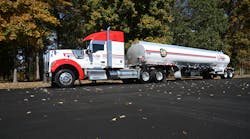MORE than $5.1 trillion in capital expenditures will take place between 2012 and 2035 across unconventional oil and natural gas activity, according to IHS Inc, a global source of information and analytics.
John Felmy, chief economist of the American Petroleum Institute, also cited other key IHS research in his presentation, “Energizing America: Facts for Addressing Energy Policy.” Felmy spoke during the National Tank Truck Carriers’ 65th Annual Conference held April 28-30 in Austin, Texas.
Key points:
• Of that $5.1 trillion, over $2.1 trillion in capital expenditures will take place in unconventional oil activity and $3 trillion in unconventional natural gas activity.
• Upstream unconventional oil and natural gas activity will support more than 1.7 million jobs in 2012, growing to some 2.5 million jobs in 2015, 3 million jobs in 2020, and 3.5 million jobs in 2035.
• On average, direct employment will represent about 20% of all jobs resulting from unconventional oil and natural gas activity with the balance contributed by indirect and induced employment.
• In 2012, unconventional oil and natural gas activity contributed nearly $62 billion in federal, state, and local tax receipts. By 2020, total government revenues will grow to just over $111 billion. On a cumulative basis, unconventional oil and natural gas activity will generate more than $2.5 trillion in tax revenues between 2012 and 2035.
“What we have right now is an opportunity that’s wonderful,” he said. “They didn’t used to understand markets and technology. With developments and technological changes in the past 15 years, we now see energy abundance: You have things like Deepwater in the Gulf of Mexico, the Oil Sands development in Canada, and hydraulic fracturing and horizontal drilling, which has dramatically changed everything.
“People think the technology of oil is some little pump jack. Well, our technology is so advanced that you wouldn’t understand it. The world has changed a lot for the oil industry. We’re now an industry that supports nine million people and over 7% of GDP (gross domestic product). The industry is owned by tens of millions of Americans in IRAs, pension funds, and 401(k)s. Unfortunately in Washington, they view the oil industry as a cookie jar. The fact of the matter is, it’s a really vital industry.”
Pennsylvania roots
Felmy grew up in Williamsport, Pennsylvania—which now finds itself in the center of the Marcellus Shale—and says the development of hydraulic fracturing, or fracking, presents an enticing economic opportunity.
“Now, if you graduate from high school and have technical skills and pass a drug test, you can support a family,” he said. “It’s really exciting. We’re seeing that in North Dakota. We’re seeing it in South Texas and potentially in California. For all of you who do business with the industry, those are things you should start thinking about. So pay attention. It presents an opportunity.”
He said people who try to “moralize” against fracking really don’t understand the situation. He said the fracking protesters are uninformed or misinformed.
“Yoko Ono recently took a bus tour through a town in Pennsylvania, where they alleged hydraulic fracturing was causing all these water problems,” he said. “The state of Pennsylvania just declared this (allegation) clearly false. Let’s get some reality instead of this rhetoric and emotion that has no basis.
“Fracking never has been demonstrated to contaminate water supplies. Period. Full stop. Never. We need to remember it’s an industrial activity.”
Ample regulations
He said fracking is well-regulated by multiple federal, state, and local authorities addressing environmental protection during natural gas operations, covering such items as well permitting, well materials and construction, safe disposition of used hydraulic fracturing fluids, water testing, and chemical recordkeeping and reporting.
“These rules and industry practices effectively protect underground sources of drinking water,” he said.
He listed government oversight regulated by states under the following federal laws:
• Clean Water Act.Surface water discharge, storm water runoff.
• Clean Air Act.Air emissions associated with processing equipment and engines.
• Safe Drinking Water Act.Underground injection disposal/reuse of produced waste and flow-back fluids.
• Federal Land Policy and Management Act.Permitting for federal onshore resources.
• National Environmental Policy Act.Permits and environmental impact statements.
• Occupational Safety and Health Act.Requires information about chemicals used at every site.
• Emergency Planning and Community Right-to-Know Act.Annual reporting to emergency responders of chemicals stored and used above certain quantities.
• Extensive State Oversight.Implement federal laws and regulate drilling fluids and produced water management.
Detailed state regulatory information available at www.STRONGERInc.org.
Felmy said the industry has not done a good job of helping the transition to fracking.
“When you move into areas like central Pennsylvania that had no history of oil and gas development, and you show up in a Louisiana pickup truck with a cowboy hat, that is probably not good community relations,” Felmy said. “So we have to be sensitive of those things in the industry. To keep the oil and gas flowing, the industry must be committed to good stewardship. This includes listening to and addressing community concerns; use of stringent industry and government standards on land reclamation, well construction, water management, and pipeline safety; responsible hydraulic fracturing practices; minimizing surface effects on land and infrastructure; practicing safe operations and pollution prevention.”
Transportation fuel
Felmy said more than 60% of energy comes from oil (35.3%) and natural gas (24.9%), and that rises to more than 80% when fossil fuels (19.9%) are factored in, according to statistics from the Energy Information Administration. He said 93% of fuel for transportation is oil and 3% is natural gas.
“I don’t see much natural gas market expansion for private vehicles because they don’t have a sufficient payback,” he said. “I’ve heard this absolutely silly statement that we need solar to reduce oil use. How? We don’t have fleets of electric cars. Even if we had a fleet of one million electric cars like the President (Obama) has articulated, you’d only save one half of 1% of gasoline use. So let’s be realistic. It can play a role, but we need liquid fuels to keep the 250 million cars and trucks on the road running for the foreseeable future. This notion that somehow we move instantly to a low-carbon future is wishful thinking.”
He said that in order to understand the relationship between crude oil prices and gasoline and diesel, crude oil needs to be converted to dollars per gallon.
“Many analysts make the mistake of trying to do percentage comparisons,” he said. “You cannot do that because of the tax wedge in gasoline and diesel.
“Also, people ask, ‘Why is diesel more expensive? Isn’t it cheaper to make?’ No, it’s not your father’s diesel fuel. We invest billions of dollars to convert to ultra-low-sulfur diesel, and it’s taxed more. All you need to do is calculate what the change is in cents per gallon of crude. The diesel market is a little less volatile than gasoline because diesel is stronger in terms of demand.
“There are different gasoline prices around the country. It’s high on the coasts because they have differences in taxation. There are very high taxes on the coast. Coastal markets also have differences in fuels—15 different types of gasoline to be exact. One question I always get is, ‘Gee, wouldn’t it be better to switch to one type of fuel?’ The problem is that you’d probably be switching to California fuel, and then everyone’s prices would go up. So be very careful what you wish for in gasoline markets.
“I also hear people say, “Prices go up like a rocket and come down like a feather.’ Well, if crude-oil prices follow that pattern, it’s not surprising.”
He said 67.3% of the price is crude and 11.8% is taxes so far in 2013.
“Earnings from our industry are six or seven cents on the dollar,” he said. “The fact of the matter is that our profits are large and earnings are large because companies are large. When you break it down in other industries, S&P company earnings are roughly 15 cents on the dollar. More companies like Apple and so on are making far more than we are.”
He said there is no direct relationship between the price of crude and depreciation of the dollar. The big issue is China.
“If you look at the forecasts, BP just indicated that China will pass us in demand by 2029,” he said. “India is growing very fast. Fortunately, the biggest supply growth is in the United States. We had the biggest increase in production in the history of the industry in terms of volumes. That’s what is really exciting. Is it because of US demand? We have a fairly weak economy, so if you look at gasoline demand, it was down because it’s tied to retail sales and employment. Diesel demand was up recently. At end of last year, it had tanked, and I was seriously worried about what was happening. Fortunately, that seems to have turned around, and this is consistent with a GDP number that was 2.5%. I view the economy through the lens of fuel demand.”
He debunked the belief that oil increases are driven by speculators.
“In Washington, we have a constant search for a villain, because if you find a villain, you can solve the problem by taking care of the villain,” he said. “Unfortunately, there aren’t many problems easily solved. If you look at the fundamentals of supply and demand, they tell you it’s not speculators. If you argue the price above the intersection of the curve for any reason—speculation, manipulation, the sun and moon and stars aligning—then you’re saying the quantity supplied is greater than the quantity demanded. That means that on a world level, you should see inventories go up. They didn’t. They didn’t in 2008. They didn’t last year. And they’re not now. If you look at the data itself, it seems to indicate it’s fundamentals.”
In the Q&A following his presentation, he was asked what trucking needs to do to become a good neighbor in the oilfield.
“I think, in general, the trucking industry is a good neighbor,” he said. “There are occasional incidents that need to be addressed. But I think the basic key is educating truck drivers to be responsible, having proper management in place, and being sensitive to the community’s interests. I think in general you’re doing a great job. We desperately need all the services you provide hauling the inputs or the outputs. It’s a wonderful opportunity going forward.” ♦









